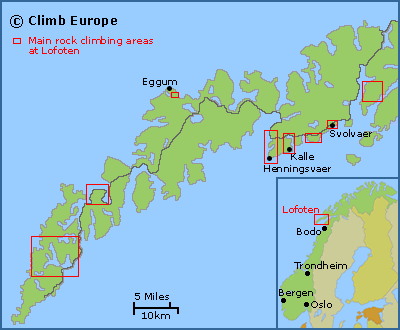Rock Climbing at Lofoten
The Lofoten Islands are located off the northwest coast of Norway, around 200km north of the Arctic Circle, and are made up of five large and five small islands. On these islands, rising from the sea, are a range of granite peaks that rise over 1,000m high and provide many excellent multi-pitch traditional routes, up to 500m long. These granite mountains offer some of the most scenic and spectacular rock climbing in Norway.

The climbing is centred on the village of Henningsvaer, complete with its own climbing café. Here and the neighbouring village of Kelle are some of the most popular and well developed crags at Lofoten.
The climbing in Lofoten is generally trad protected and on superb quality granite rock. The routes range from easy and accessible to hard and remote, from single pitch to twenty pitches, and everything in between. There are even some sport routes as well, but climbers tend to come to Lofoten for the long trad multipitch routes, as they are inspired to climb the big wall routes at places such as the Preston and Pillaren walls. It is the variety of climbing to be found that attracts climber to Lofoten, with routes across a wide range of grades from English Severe to E8 or French 3 to 8b. In addition to the routes at Lofoten there is a great variety of bouldering to be found as well.
Map of the rock climbing areas at Lofoten

Lofoten climbing logistics and beta
The best guidebook for the area is simply called Lofoten Climbs published by Rockfax in April 2024. The guidebook covers a wide range of grades from Norwegian 4 to 9 (English Severe to E8 or French 3 to 8b). There is a good range of traditional multi-pitch routes, both short and long, plus single pitch sport routes. It covers over 550 trad routes and over 120 sport routes. It also describes a selection of routes on the mainland at Stetind and Narvik. The Bouldering in Lofoten guidebook covers more than 700 problems in 24 separate bouldering areas across Lofoten. Buy these guidebooks for Lofoten from our shop.
The best time to climb at Lofoten is during the summer months of June, July and August. During this time the weather usually is stable, coupled with the added advantage of having sunlight 24 hours per day, you can start climbing whenever you want.
Getting to Lofoten is a major undertaking in itself, as it is a long way from the rest of Europe. Ideally it makes sense to go for at least 2 weeks and longer if possible. Access to the Lofoten islands is via Bodo, where you can either fly into Svolvaer, or hire a car and catch the ferry to Svolvaer. An internal flight is required to get to Bodo, and these are available from Oslo, Bergen or Trondheim airports. The Lofoten Climbs guidebook also gives extensive information on the various options of travelling to Lofoten.